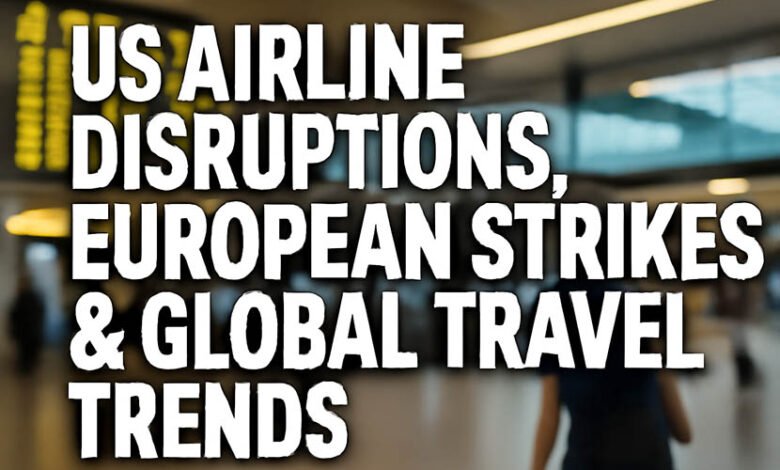Chaos & Growth: US Airlines Promising Wild Ride Amid Challenges and Growth!

Travel News Update: July 25
On July 25, the travel landscape, particularly in the United States, witnessed a blend of challenges and advancements. This day marked significant shifts in airline operations characterized by widespread disruptions while concurrently revealing steadfast growth in routes and expansions among U.S. airlines. This blog post analyzes these dynamics, the ongoing European strikes, and how various challenges are being navigated within the travel industry.
US Airlines Face Widespread Disruptions
The world of aviation is no stranger to disruptions, but the extent of chaos that unfolded on July 25 was particularly notable. Major U.S. airlines experienced extensive delays and cancellations across the board. Factors such as adverse weather conditions, staffing shortages, and high travel demand combined to exacerbate the situation, affecting tens of thousands of travelers nationwide.
Weather-related disruptions played a significant role, driven largely by thunderstorms in key transit hubs. Areas such as the Northeast were hit particularly hard, causing ripple effects that extended well beyond just a few states. In addition, intense heat waves in the southern U.S. led to operational challenges that hindered flight schedules. For instance, places like Texas experienced not only travel disruptions but also implications for safety as temperatures soared, raising concerns about the efficiency of operational machinery.
Staffing Shortages Add to the Complexity
Chronically underfunded and understaffed, airlines continue to grapple with workforce shortages that have only intensified due to the recent travel surge post-pandemic. With airlines unable to keep pace with recovery, many reported a lack of availability of ground staff, air traffic controllers, and maintenance crews necessary to facilitate smooth operations, leading to increased delays and cancellations.
Furthermore, many airline employees are still recovering from the trauma of the pandemic and need more time to adjust back to the rigors of high-demand travel seasons. This disconnect has caused significant operational bottlenecks, leading to further frustration for both customers and airline operators.
Continuing Route Expansions Despite Challenges
On a brighter note, the same day also showcased robust growth for several U.S. airlines. Despite facing challenges, many carriers reported successful expansions of both domestic and international routes. This strategic growth aims to mitigate the impact of disruptions by offering travelers more options and flexibility, thus meeting the high demand that continues to surge.
For example, major airlines unveiled new routes connecting traditionally underserved markets. These expansions are not only about increasing the number of available seats in the market but also about establishing more convenient connections that enhance the travel experience overall. With travelers eager to return to international travel, airlines are keen on expanding their reach to accommodate this growing interest in vacationing overseas.
The Prospects of Domestic Route Growth
The domestic air travel sector demonstrated notable resilience, with airlines focusing on enhancing their domestic route offerings to meet the rising demand. Airlines added routes from secondary cities to major hubs, encouraging travelers from smaller markets to explore various destinations. This expansion strategy contributes to the revitalization of the hospitality and tourism sectors in local economies.
Moreover, as more routes become available, airlines are emphasizing the importance of competitive pricing and flight frequency, providing travelers ample choices. The growing number of options is crucial as it not only caters to leisure travelers looking for affordable vacations but also helps business travelers seeking expedient options. Airlines remain committed to ensuring that they can adapt and respond to demand fluctuations while attempting to maximize the profitability and sustainability of their operations.
Impact of European Strikes on Global Travel Dynamics
European strikes primarily stemmed from labor disputes in various sectors, including transport, and they resulted in extensive delays and cancellations across the continent. Major airports, already struggling to meet post-pandemic demand, were further strained by the strikes, prompting some airlines to prioritize affected passengers, particularly those on international flights. For U.S. airlines operating transatlantic routes, navigating these sudden changes became crucial in maintaining customer satisfaction and loyalty.
Strategies for Improvement
In light of the various challenges, airlines are looking to bolster their operations by implementing several strategic measures. Investment in technology and personnel is paramount as airlines seek to streamline operations while improving the customer experience.
Many airlines are enhancing their digital tools to facilitate better communication with passengers regarding flight changes, delays, and cancellations. Improved technology can help ensure that travelers are kept informed and can make alternative arrangements as swiftly as possible, minimizing frustrations during travel disruptions.
Furthermore, airlines aim to bolster their workforce through training programs and new hiring processes. By investing in areas such as recruitment, retention, and staff training, organizations can build a more capable workforce prepared to handle peak traveling seasons effectively.
Conclusion: Navigating a New Travel Era
The travel industry is in a continual state of evolution, grappling with a series of challenges while simultaneously looking ahead to expansive growth opportunities. On July 25, U.S. airlines displayed resilience through their strategic expansion efforts amidst widespread disruptions, characterized by adverse weather, staffing shortages, and international challenges from European strikes.
As the industry adapts to these shifts, both airlines and travelers must navigate the new normal of air travel. While unpredictability may remain a constant, the focus on enhancing travel options, improving operational efficiency, and maintaining customer satisfaction remains a priority for airlines. The future of travel promises the excitement of new destinations paired with the potential for unpredictable hurdles. The journey continues for travelers and airlines alike.
Summary
- On July 25, U.S. airlines faced significant disruptions due to adverse weather and staffing shortages.
- Despite the challenges, airlines pursued route expansions, highlighting resilience in the domestic sector.
- The surge in travel demand is prompting airlines to enhance domestic routes and provide more options.
- Strikes in Europe created additional complexities for global travel, impacting transatlantic flights.
- Investment in technology and workforce development remains critical for future improvement.





